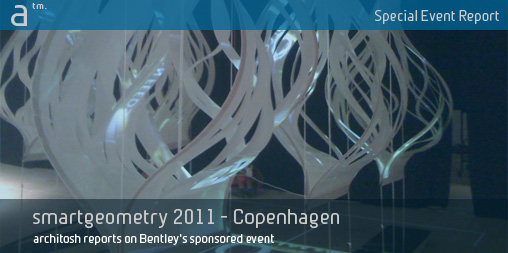Continued from page 1
Urban Feeds
Another interesting cluster was Urban Feeds, led by Luis E. Fraguada, Tomas Diez and Felipe Pecegueiro. This group focused at the urban scale and had a large array of model-to-projection displays within their cluster area (see image 03-05). It was not always easy to understand the theoretical goals behind some of their investigations. However, the techniques and technology used was very interesting.
The group used sensor data, captured from the city of Copenhagen and connected to Grasshopper through gHowl, a set of custom software components. They were interested in generating design based on relationships between two or more sensor parameters.
One example projected a map of color-coded terrain onto a 3D pliable (analog) model. Adjustments could be made to the model, and agents–projected onto the model–would respond to changes in the analog model terrain. (see image 03). In one case agents would avoid activity in an area that combined two data inputs (like steep terrain, measured in 3D and temperature). Agents (people) would be represented by dots. The dots would move in response to real-time data changes. If I pushed the analog model with my fingers to create steep terrain in an area of high temperature the agents would move from that zone to another zone. (see image 04).
Advertisement
Other cluster workshops that caught our attention included Responsive Acoustic Surfaces, Agent Construction and Hybrid Space Structures. In the first the aim was to evaluate a new generation of parametric tools that embed what the conference called “emergent” behavior in parametric models. Swarming, Flocking, Cellular Automata, Genetic Algorithms and Dynamic Relaxation are all examples of emergent tools. The cluster searched for new forms for acoustic surface design that accentuate certain frequencies of sound and muffle others. (see image 06)
In the second cluster invisible processes–in this case air and energy–generated by emerging structures can be visualized during the construction process in an effort to aid the ongoing fabrication in real time. Rather than starting with a pre-designed blue-print of a structure, a feedback loop linking the emergent structure with invisible processes informs the ongoing construction. This work was oriented to the research of Rupert Soar (who we will write more about later) which deals with transient ventilation strategies and structural homeostasis within termite mounds. (see image 07-08)
Finally, the last cluster we will highlight worked on hybrid space structures based on modular polyhedra first made popular in the 1960’s but now being used again in non-modular formation. The cluster participants used Generative Components and/or Grasshopper to make precise parametric models of non-modular space structures. “Seed” templates were given to each participant to explore (these consisted of tessellated and scripted armatures and compatible components in GC and Grasshopper).
This cluster also used the software tool Karamba, a parametric structural evaluation tool developed by cluster leader Dr. Clemens Preisinger and Bollinger-Grohmann Schneider Engineers. Karamba is a FE (Finite Element) plugin for Grasshopper that allows designers to interactively calculate and analyse the 3D forces on a structural system. Karamba generates an intuitive “feedback loop” between physical behavior and geometry to inform design decisions. (see image 09)
We will publish a gallery of images from the event and conference a bit later. For more information and to read on all the work of the cluster workshops go here.












Reader Comments
[…] now every man, dog and archinet, has taken the Smart Geometry website and condensed it into a blog post. In […]
This is an excellent new article on the Arduino boards:
http://mac.tutsplus.com/tutorials/electronics/arduino-an-introduction/?utm_source=feedburner&utm_medium=feed&utm_campaign=Feed%3A+mactuts+%28Mactuts%2B%29
Comments are closed.